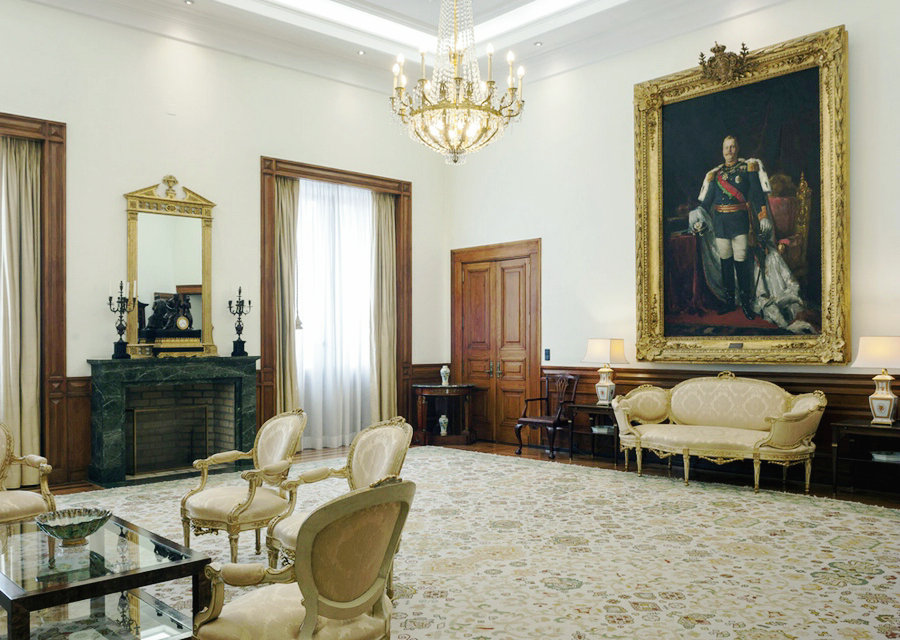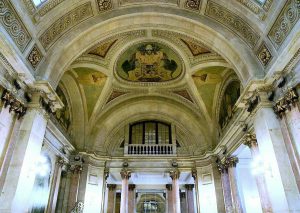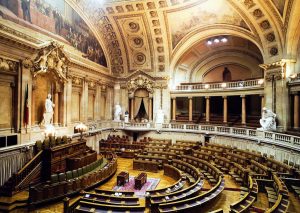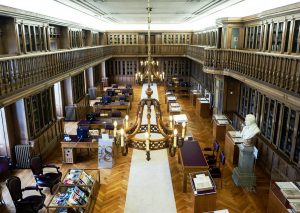In the Gallery of Presidents, which gives access to the Office of the President of the Assembly of the Republic, are the portraits of the President of the Constituent Assembly, Henrique de Barros, by Pedro Girão (1997), and the 12 former Presidents of the Assembly of the Republic, Vasco da Gama Fernandes, Teófilo Carvalho dos Santos, both also by Pedro Girão (1997), Leonardo Ribeiro de Almeida, by Fernando Alves de Sousa (1997), Francisco de Oliveira Dias, by Maria Antónia Machado (1997), Manuel Tito de Morais, by Pinheiro de Santa Maria (1998), Fernando Amaral by Fernando Alves de Sousa (1997), Victor Crespo, by Maluda (1997), António Barbosa de Melo, by Ana Duarte de Almeida (1997), António Almeida Santos, by António Macedo (2002), João Bosco Mota Amaral, by João Cruz Rosa (2005), Jaime Gama,Isabel Garcia (2011) and Maria da Assunção Esteves, Isabel Guerra Peñamaria (2016).
In this corridor is the Presidency table of the former Chamber of Deputies (1834-1895), a showcase where some of the institutional offers are presented to the Presidents of the Assembly of the Republic and a case is also displayed with a case with a mechanism manufactured by the London master watchmakers William Trippett and Jacob Garon, at the beginning of the 18th century, which belonged to the Monastery of São Bento.
Portrait of Henrique de Barros, Pedro Girão, 1997.
Portrait of Vasco da Gama Fernandes, Pedro Girão, 1997.
Portrait of Teófilo Carvalho dos Santos, Pedro Girão, 1997.
Portrait of Leonardo Ribeiro de Almeida, Fernando Alves de Sousa, 1997.
Portrait of Francisco de Oliveira Dias, Maria Antónia Machado, 1997.
Portrait of Tito de Morais, Pinheiro de Santa Maria, 1998.
Portrait of Fernando Amaral, Fernando Alves de Sousa, 1997.
Portrait of Vítor Crespo, Maluda, 1997.
Portrait of Barbosa de Melo, Ana Duarte de Almeida, 1997.
Portrait of Almeida Santos, António Macedo, 2002.
Portrait of Mota Amaral, João Cruz Rosa, 2005.
Portrait of Jaime Gama, Isabel Garcia, 2011.
Portrait of Maria Assunção Esteves, Isabel Guerra Peñamaria, 2016.
President’s Office
The office of the President of the Assembly of the Republic presents pieces of furniture, painting, textiles and porcelain in its decoration.
With regard to furniture, this space is filled, in particular, by a large Dutch-style cabinet in brown wood, with four doors and two drawers, with a lateral and central colonnade, raised cushions and the respective raised carved in relief. representing mythological animals, among others. The work desk is also large, rectangular in shape, hollow in the central area, with six anterior and six posterior drawers, these false ones, with handles or cut-out and gilded brass fittings in the shape of an anchor, the corresponding top being lined with red skin. One of the corners of the space under analysis is decorated with a small rotating mahogany bookcase. The meeting table has a rectangular and ovoid shape, with a top covered in the same shade as the desk and topped with engraved golden fillets, and resting on rectangular legs and feet. The chairs around it consist of armchairs copied from the originals used by the Constituent Deputies of 1834, with a velvet seat and a hollow back filled with hexagon. The rest of the furniture consists of a sofa and twobergères, both upholstered in chenil fabric in orange tones, and two small circular support tables topped by beige porcelain lamps in the shape of a pot.
Also in the line of furniture worthy of reference is a classic chandelier in golden bronze and with 24 arms.
As for textiles, in this cabinet there are two pieces worthy of mention and high quality, namely a 17th century Italian tapestry and a recent Arraiolos rug, both of large dimensions.
The Italian tapestry, polychrome and rectangular in shape, represents the first biblical family – Adam and Eve with Cain and Abel – and is the double authorship of Pietro Ferloni (weaver) and Domenico Paradisi (painter), being placed on a wall next to the table. meetings. The aforementioned carpet, also polychrome, on which the meeting table and chairs rests, has a vegetal decoration, with a symmetrical band and topped by fringe.
In relation to the painting, the wall next to the work desk is filled with a 17th century oil painting on canvas by the French painter Jean de Boulogne (1591-1632), entitled “Mercury and Argus”, and which represents in a bucolic framing these two mythological characters. This work from the collection of the National Museum of Ancient Art is on deposit in the Assembly of the Republic.
Presidency living room
The current visiting room of the Presidency of the Assembly of the Republic, where the Council of Ministers met during the Estado Novo, presents in its decoration pieces of painting, furniture, ceramics, sculpture and textiles.
In relation to the painting, one of the walls is decorated by an allegorical oil on canvas from the collection of the National Museum of Ancient Art (MNAA), entitled “Minerva and the Arts” and attributed to Louis Jean François Lagrenée (18th century), and on the wall opposite is a portrait of D. Carlos I by José Malhoa (19th century).
With regard to furniture, the space is filled with a set consisting partially of a settee and seven Louis XVI style armchairs, as well as eight chairs (five with arms and three without arms) in mahogany with a Chippendale-style leather seat.
The respective decoration also comprises two elevations with a four-drawer showcase with exposed pieces – some offered to the President on official trips; four small rectangular support tables topped by four carved porcelain lamps (Fábrica Vista Alegre), two circular Empire II style tables with an elliptical green marble top, a golden mirror topped by a D. Maria e style vase cornice with plant motifs from the early 19th century. Finally, a bronze and crystal chandelier in the shape of a shower is suspended from the ceiling.
Filling one of the elliptical corner tables, a small plaster bust, a representative figure of the Republic, by Simões de Almeida, nephew, can be seen. In the other, two small earthenware pots (MNAA collection) are appreciated.
At the top of the fireplace, there is a set of clock and two 19th century French chandeliers, in black marble and matte bronze ornaments, detecting the signs of the Zodiac and a pair of Greek-Roman mythology (Cronos and Reia, or Jupiter and Juno).
The floor is covered by a large Arraiolos rug, polychrome and rectangular in shape, with symmetrical and vegetal decoration.
São Bento Palace
The São Bento Palace is a palace – style neoclassical located in Lisbon, being the seat of the Parliament of Portugal since 1834. It was built in the late sixteenth century (1598) as a monastery Benedictine (Monastery of St. Benedict Health) for traces of Baltazar Álvares, with a mannerist and baroque character. The National Archive of Torre do Tombo was installed there. With the extinction of religious orders in Portugal it became the property of the State. In the 17th century, the crypts of the marquises of Castelo Rodrigo were built.
After the establishment of the liberal regime in 1834, after the Portuguese Civil War, it became the headquarters of the Cortes Gerais da Nação, becoming known as the Palácio das Cortes. Following the changes in the official name of the Parliament, the Palace was also given several official names: Palácio das Cortes (1834-1911), Palácio do Congresso (1911-1933) and Palácio da Nacional Assembly (1933-1974). In the mid-twentieth century, the designation of Palácio de S. Bento started to be used, in memory of the old Convent. This denomination remained after 1976, when it became the seat of the Assembly of the Republic.
Throughout the 19th and 20th centuries, the Palace underwent a series of major remodeling works, both interior and exterior, which made it almost completely distinct from the old Monastery, of which the remodeling by Ventura Terra and in 1936 the monumental staircase, added by António Lino and completed by Cristino da Silva. The Palace has a central body with arcades on the ground level and over these colonnaded gallery, topped by a triangular pediment decorated with stuccoes. The interior is equally grand, full of wings, and the Chamber of Deputies’ Room of Sessions, the Room of the Lost Steps, the Noble Hall, among others, as well as works of art from different periods in the history of Portugal. The Palace also includes a Historical Museum, having been classified as a National Monument in 2002.
In 1999, the new building was inaugurated, which supports the Assembly of the Republic. Located in the square of S. Bento, the new building, a 1996 project by the architect Fernando Távora, although connected to the palace by direct interior access, was purposely built in order to be an autonomous structure in order not to compromise or mischaracterize the palace layout.







